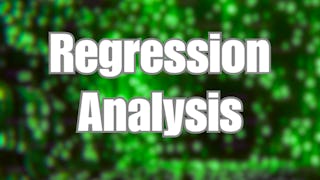This course focuses on one of the most important tools in your data analysis arsenal: regression analysis. Using either SAS or Python, you will begin with linear regression and then learn how to adapt when two variables do not present a clear linear relationship. You will examine multiple predictors of your outcome and be able to identify confounding variables, which can tell a more compelling story about your results. You will learn the assumptions underlying regression analysis, how to interpret regression coefficients, and how to use regression diagnostic plots and other tools to evaluate the quality of your regression model. Throughout the course, you will share with others the regression models you have developed and the stories they tell you.

Enjoy unlimited growth with a year of Coursera Plus for $199 (regularly $399). Save now.

Regression Modeling in Practice
This course is part of Data Analysis and Interpretation Specialization


Instructors: Jen Rose
35,417 already enrolled
Included with
(274 reviews)
Skills you'll gain
Details to know

Add to your LinkedIn profile
See how employees at top companies are mastering in-demand skills

Build your subject-matter expertise
- Learn new concepts from industry experts
- Gain a foundational understanding of a subject or tool
- Develop job-relevant skills with hands-on projects
- Earn a shareable career certificate

There are 4 modules in this course
This session starts where the Data Analysis Tools course left off. This first set of videos provides you with some conceptual background about the major types of data you may work with, which will increase your competence in choosing the statistical analysis that’s most appropriate given the structure of your data, and in understanding the limitations of your data set. We also introduce you to the concept of confounding variables, which are variables that may be the reason for the association between your explanatory and response variable. Finally, you will gain experience in describing your data by writing about your sample, the study data collection procedures, and your measures and data management steps.
What's included
4 videos5 readings1 peer review
In this session, we discuss more about the importance of testing for confounding, and provide examples of situations in which a confounding variable can explain the association between an explanatory and response variable. In addition, now that you have statistically tested the association between an explanatory variable and your response variable, you will test and interpret this association using basic linear regression analysis for a quantitative response variable. You will also learn about how the linear regression model can be used to predict your observed response variable. Finally, we will also discuss the statistical assumptions underlying the linear regression model, and show you some best practices for coding your explanatory variables Note that if your research question does not include one quantitative response variable, you can use one from your data set just to get some practice with the tool.
What's included
8 videos9 readings1 peer review
Multiple regression analysis is tool that allows you to expand on your research question, and conduct a more rigorous test of the association between your explanatory and response variable by adding additional quantitative and/or categorical explanatory variables to your linear regression model. In this session, you will apply and interpret a multiple regression analysis for a quantitative response variable, and will learn how to use confidence intervals to take into account error in estimating a population parameter. You will also learn how to account for nonlinear associations in a linear regression model. Finally, you will develop experience using regression diagnostic techniques to evaluate how well your multiple regression model predicts your observed response variable. Note that if you have not yet identified additional explanatory variables, you should choose at least one additional explanatory variable from your data set. When you go back to your codebooks, ask yourself a few questions like “What other variables might explain the association between my explanatory and response variable?”; “What other variables might explain more of the variability in my response variable?”, or even “What other explanatory variables might be interesting to explore?” Additional explanatory variables can be either quantitative, categorical, or both. Although you need only two explanatory variables to test a multiple regression model, we encourage you to identify more than one additional explanatory variable. Doing so will really allow you to experience the power of multiple regression analysis, and will increase your confidence in your ability to test and interpret more complex regression models. If your research question does not include one quantitative response variable, you can use the same quantitative response variable that you used in Module 2, or you may choose another one from your data set.
What's included
10 videos2 readings1 peer review
In this session, we will discuss some things that you should keep in mind as you continue to use data analysis in the future. We will also teach also you how to test a categorical explanatory variable with more than two categories in a multiple regression analysis. Finally, we introduce you to logistic regression analysis for a binary response variable with multiple explanatory variables. Logistic regression is simply another form of the linear regression model, so the basic idea is the same as a multiple regression analysis. But, unlike the multiple regression model, the logistic regression model is designed to test binary response variables. You will gain experience testing and interpreting a logistic regression model, including using odds ratios and confidence intervals to determine the magnitude of the association between your explanatory variables and response variable. You can use the same explanatory variables that you used to test your multiple regression model with a quantitative outcome, but your response variable needs to be binary (categorical with 2 categories). If you have a quantitative response variable, you will have to bin it into 2 categories. Alternatively, you can choose a different binary response variable from your data set that you can use to test a logistic regression model. If you have a categorical response variable with more than two categories, you will need to collapse it into two categories.
What's included
7 videos6 readings1 peer review
Earn a career certificate
Add this credential to your LinkedIn profile, resume, or CV. Share it on social media and in your performance review.
Offered by
Explore more from Probability and Statistics
 Status: Free Trial
Status: Free TrialJohns Hopkins University
 Status: Free Trial
Status: Free TrialUniversity of Colorado Boulder
 Status: Free Trial
Status: Free Trial Status: Free Trial
Status: Free TrialUniversity of Colorado System
Why people choose Coursera for their career




Learner reviews
274 reviews
- 5 stars
62.04%
- 4 stars
25.18%
- 3 stars
6.20%
- 2 stars
3.64%
- 1 star
2.91%
Showing 3 of 274
Reviewed on Mar 14, 2016
Great but too much stock video footage of people smoking.
Reviewed on Dec 4, 2016
This is a great beginner level course for those have no programming experience. But I would suggest the content to be extended to 8 weeks instead of 4 weeks.
Reviewed on Apr 13, 2021
Great explanation of stat and useful coding examples.
Frequently asked questions
To access the course materials, assignments and to earn a Certificate, you will need to purchase the Certificate experience when you enroll in a course. You can try a Free Trial instead, or apply for Financial Aid. The course may offer 'Full Course, No Certificate' instead. This option lets you see all course materials, submit required assessments, and get a final grade. This also means that you will not be able to purchase a Certificate experience.
When you enroll in the course, you get access to all of the courses in the Specialization, and you earn a certificate when you complete the work. Your electronic Certificate will be added to your Accomplishments page - from there, you can print your Certificate or add it to your LinkedIn profile.
Yes. In select learning programs, you can apply for financial aid or a scholarship if you can’t afford the enrollment fee. If fin aid or scholarship is available for your learning program selection, you’ll find a link to apply on the description page.
More questions
Financial aid available,





